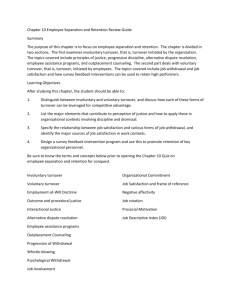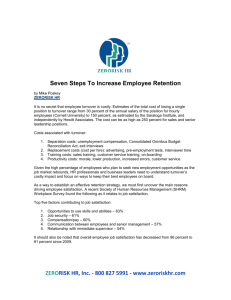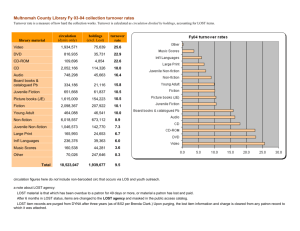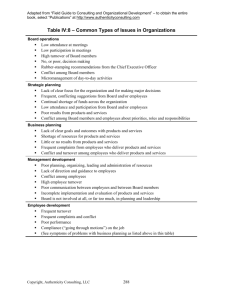Retaining and Rewarding the Key Employees Analyzing and
advertisement
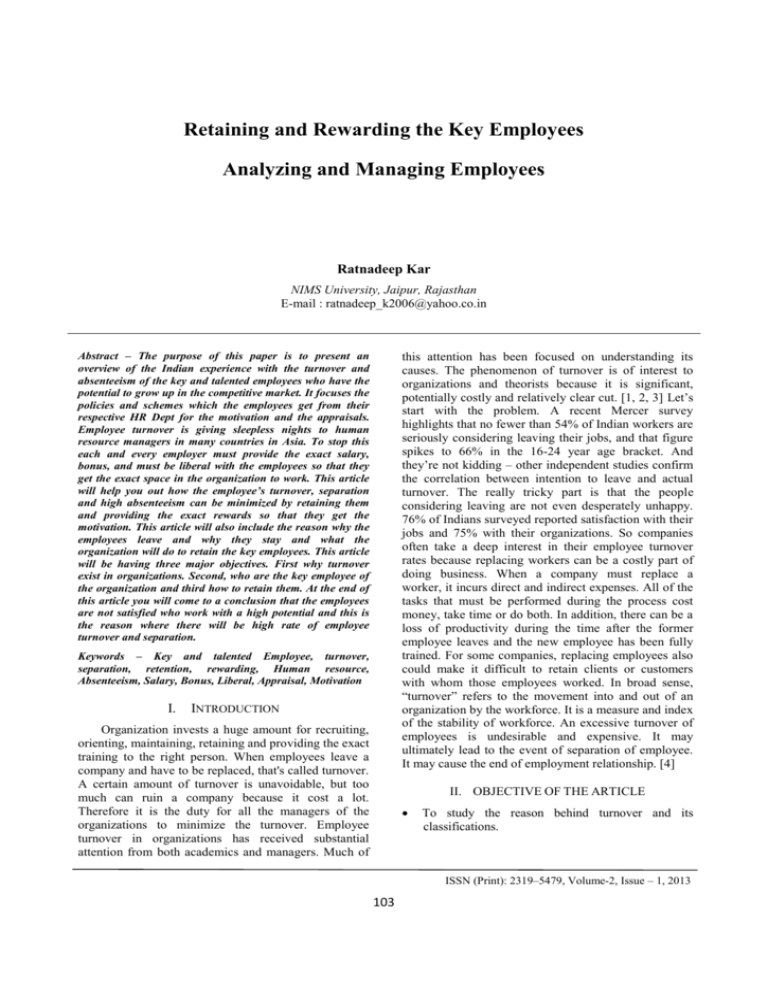
Retaining and Rewarding the Key Employees Analyzing and Managing Employees Ratnadeep Kar NIMS University, Jaipur, Rajasthan E-mail : ratnadeep_k2006@yahoo.co.in Abstract – The purpose of this paper is to present an overview of the Indian experience with the turnover and absenteeism of the key and talented employees who have the potential to grow up in the competitive market. It focuses the policies and schemes which the employees get from their respective HR Dept for the motivation and the appraisals. Employee turnover is giving sleepless nights to human resource managers in many countries in Asia. To stop this each and every employer must provide the exact salary, bonus, and must be liberal with the employees so that they get the exact space in the organization to work. This article will help you out how the employee’s turnover, separation and high absenteeism can be minimized by retaining them and providing the exact rewards so that they get the motivation. This article will also include the reason why the employees leave and why they stay and what the organization will do to retain the key employees. This article will be having three major objectives. First why turnover exist in organizations. Second, who are the key employee of the organization and third how to retain them. At the end of this article you will come to a conclusion that the employees are not satisfied who work with a high potential and this is the reason where there will be high rate of employee turnover and separation. this attention has been focused on understanding its causes. The phenomenon of turnover is of interest to organizations and theorists because it is significant, potentially costly and relatively clear cut. [1, 2, 3] Let‟s start with the problem. A recent Mercer survey highlights that no fewer than 54% of Indian workers are seriously considering leaving their jobs, and that figure spikes to 66% in the 16-24 year age bracket. And they‟re not kidding – other independent studies confirm the correlation between intention to leave and actual turnover. The really tricky part is that the people considering leaving are not even desperately unhappy. 76% of Indians surveyed reported satisfaction with their jobs and 75% with their organizations. So companies often take a deep interest in their employee turnover rates because replacing workers can be a costly part of doing business. When a company must replace a worker, it incurs direct and indirect expenses. All of the tasks that must be performed during the process cost money, take time or do both. In addition, there can be a loss of productivity during the time after the former employee leaves and the new employee has been fully trained. For some companies, replacing employees also could make it difficult to retain clients or customers with whom those employees worked. In broad sense, “turnover” refers to the movement into and out of an organization by the workforce. It is a measure and index of the stability of workforce. An excessive turnover of employees is undesirable and expensive. It may ultimately lead to the event of separation of employee. It may cause the end of employment relationship. [4] Keywords – Key and talented Employee, turnover, separation, retention, rewarding, Human resource, Absenteeism, Salary, Bonus, Liberal, Appraisal, Motivation I. INTRODUCTION Organization invests a huge amount for recruiting, orienting, maintaining, retaining and providing the exact training to the right person. When employees leave a company and have to be replaced, that's called turnover. A certain amount of turnover is unavoidable, but too much can ruin a company because it cost a lot. Therefore it is the duty for all the managers of the organizations to minimize the turnover. Employee turnover in organizations has received substantial attention from both academics and managers. Much of II. OBJECTIVE OF THE ARTICLE To study the reason behind turnover and its classifications. ISSN (Print): 2319–5479, Volume-2, Issue – 1, 2013 103 International Journal of Research and Development - A Management Review (IJRDMR) To study who are the key employees of the organization. To study the ways to retain them. and for high performance where the employee do not want to leave can be named as functional retention. III. EMPLOYEE TURNOVER –CLASSIFICATIONS AND REASONS Turnover occurs for many different reasons. Sometimes new job attracts employees and pull them to leave the old one. In contrary employee also pushed to leave job due to the dissatisfaction in their present workplace or by domestic circumstances when someone reallocates with their spouse or partner. [5] The impact of turnover has received considerable attention by senior management, human resources professionals, and industrial psychologists. It has proven to be one of the most costly and seemingly intractable human resource challenges confronting organizations. The calculation for the rate of the turnover of the employees can be calculated as under: Table 1 In today's tight labor market, the ability to attract and retain employees is a major concern for employers of any size organization. Statistics indicate this labor shortage will continue for the foreseeable future. In order to resolve turnover issues, the first step is to identify the reasons why your employees leave. Exit interviews, employee attitude surveys, or employee focus groups can be valuable tools for identifying those reasons. So from Table 2 we can see that there are many reasons for an employee to leave the organization. The meaning of the same are provided below: For example, a company has 100 employees at the start of the year. During the year six employees quit and nine get let go in a layoff late in the year. The voluntary turnover rate for the year would be 6/100 or 6%. The involuntary turnover rate was 9/100 or 9%. The total turnover rate would be calculated as 15/100 or 15% because the six employees who left voluntarily and the nine who were laid off are added together. A. Demographic Variables There are generally two types of turnover as provided in table 1. They are voluntary and involuntary. Voluntary turnover is when the employee chooses to leave the organization for whatever reason. Involuntary turnover is caused by layoffs and similar actions where the decision for an employee to leave is made by the company and not the employee. There are huge amount of demographic variables which affect a lot to the employees which forces them to turn off the existing job. Commonly said demographics variables include gender, race, age, disabilities, mobility, educational level and many more. Out of this the gender, age and education level is the most vital for which the employee‟s attitude changes and they tend to search out new jobs for not getting satisfaction which leads to absenteeism and at last turnover. Gender distinction plays a vital role. It is seen that a women with a good look get the promotion very easily in compared to a man. Professional women should use their "erotic capital" - beauty, sex appeal, charm, dress sense, liveliness, and fitness - to get ahead at work [6]. Women tended to get more than men. Men also tended to have effective relationship than women. Age is also one of the important variables. Compared with the „normal distribution‟ there were significantly less persons between the ages 20-34 than there should be and considerably more persons over 50 years of age than there should be in the satisfied category. Thus, young employees tended to be disqualified and older employees satisfied. Thus the younger employees tend As a general rule, voluntary turnover is the measure used to discuss and compare employers. It is the type most directly affected by the front line supervisors. Involuntary turnover, caused by layoffs, can be a longterm result of high levels of voluntary turnover. In the above table it is shown that that the x axis represents the employee contribution to the organization and the y axis represents the employees‟ choice for leaving the job voluntary or not. According to the table it is clear that the employee whose performance is high and who wants to quit the organization can be said as Dysfunctional turnover and for low performance it is functional turnover. Where the performance of the employee is low and there is no intention for the employees to leave the organization then it is called Dysfunctional retention, ISSN (Print): 2319–5479, Volume-2, Issue – 1, 2013 104 International Journal of Research and Development - A Management Review (IJRDMR) to de-motivate and the employees switch off their job [7]. There is also a relationship between education level and job satisfaction. It is found that education increases job satisfaction. The provision of training will foster an increase in professionalism and further exploitation of management methods, whereas a lack of training can cause frustration and lack of job satisfaction (Wright and Davis, 2003). Bluedorn (1982) highlighted demographic characteristics such as race, age, education and payment that affect job expectations and environmental opportunities, which ultimately influence turnover and job satisfaction. C. Organizational Variables Organizational satisfaction is the terminology used to describe whether employees are happy and contented and fulfilling their desires and needs at work. Many measures purport that organization satisfaction is a factor in firm size, industry type, job contents and working environment. It is the problem for all the small firm or industries. The candidates who passed out as a fresher search a small firm job so that they can gather the experience and training and they can utilizing the same in other big firm industries with a hike in their salary. For the same they do not have a specific reason for leaving the job. But the reason can be for a better opportunity and a better brand name. A work environment is made up of a range of factors, including company culture, management styles, hierarchies and human resources policies. Workplace environments greatly influence employee satisfaction, which in turn directly affects employee turnover rates. Knowing how to use a positive work environment to increase employee satisfaction and reduce turnover is a key to developing a high-performance workforce. B. Occupational Variables According to Table 2 it can be seen that each and every individual has different or same taste. People differ from one to another in many ways e.g. height, weight, speed, age etc. Generally it is stated that motor skills are initially dependent on the physical fitness of the person. A person with less physical fitness skill will obviously skip the job as because he/she will not be getting the exact satisfaction. Not only the skill level but also the experience of the employees matters a lot for the satisfaction. It can be understood that the person who has a good experience will always think that he can get a good opportunity in other organization and they will be searching for alternatives. On the other hand the employees who have less experience will not obviously get the exact satisfaction and they are eager to change the present job. According to Henry Fayol‟s (18411925) 14 principles of Management „Stability of tenure of Personnel‟ plays a vital role. Retaining productive employees should always be a high priority of the management. D. Industrial Variables Maslow‟s Hierarchy scale provides that if the security need of an employee is not fulfilled the employee will not get the exact job satisfaction which tends to absenteeism and ultimately turnover. Employees work better if job security and career progress are assured to them. An insecure tenure and a high rate of employee turnover will affect the organization adversely. After Maslow, the Two-factor theory (also known as Herzberg's motivation-hygiene theory and Dual-Factor Theory) states that there are certain factors in the workplace that cause job satisfaction, while a separate set of factors cause dissatisfaction. Herzberg divided the total factors into two categories. Hygiene factors are those job factors which are essential for existence of motivation at workplace. Hygiene factors include: - Company policy and administration- Wages, salaries and other financial remuneration- Quality of supervision- Quality of inter-personal relationsWorking conditions- Feelings of job security. Another classification is called motivational factor. These factors motivate the employees for a superior performance. Motivator factors include: - Status- Opportunity for advancement- Gaining recognition- ResponsibilityChallenging / stimulating work- Sense of personal achievement & personal growth in a job. IV. SEARCHING OUT THE KEY EMPLOYEES There is a lot of talk about key employees and an absolute reliance on identification and ring-fencing of such employees for critical HR processes is an important Table 2 ISSN (Print): 2319–5479, Volume-2, Issue – 1, 2013 105 International Journal of Research and Development - A Management Review (IJRDMR) one. According to many authors and critics the search out of the potential employee can be jotted down: An employee who would be a regrettable loss if they left the company High Performers or high potentials Employees who consistently deliver tangible business value and positive business outcomes; Key individuals e.g. a particular person who has developed and maintains a critical business system; Employees with large amounts of intellectual property (IP) in their heads A critical mass of employees where they all perform the same role which is critical to business success People with rare talents or skills or who belong to a small global talent pool; Employees who occupy a role that would take a long time to fill; Employees who occupy a role and who would be expensive or difficult to replace; some cases low salary, lack of growth prospects and motivation compel an employee to look for a change. The management must try its level best to retain those employees who are really important for the system and are known to be effective contributors. Yet, unknown to most managers, retaining good staff ideally begins during the recruitment phase. To remain competitive, you must create a talent powered company consisting of highly motivated, skilled, and loyal employees [10]. But for the same the employers must provide them the exact motivation. Employee retention refers to the various policies and practices which let the employees stick to an organization for a longer period of time. Every organization invests time and money to groom a new joinee, make him a corporate ready material and bring him at par with the existing employees. The organization is completely at loss when the employees leave their job once they are fully trained. Employee retention takes into account the various measures taken so that an individual stays in an organization for the maximum period of time. From the traditional point of view the retention of the employees mainly depend upon the five main factors: Employees who have a high Industry or public profile or hold the key to a valuable business network. In truth all of the above are probably true but collectively they make definition of a key employee imprecisely. From the above list we can assume that the employees who are in this stage can be said as the key employees. Compensation and benefits of the employees Working Environment Growth and prospect Relation among the peers Support by the higher authority. In the modern time as because the HR concept is changing in a high speed the ideas for retaining the key employees also changed. New and innovative ideas came into existence for retaining the employees. Some and few ideas are jotted down: V. MINIMIZING TURNOVER AND RETAINING THE KEY EMPLOYEES Implement Good Management Practices. Hiring employees is just a start to create a strong work force. For recruiting a qualified and experienced candidate it is the duty and responsibility of the organization to provide a huge amount to get the best from the market. But if the employees after getting the job do not get the required satisfaction then there will be absenteeism which tends to turnover. Losing a single key worker can decrease the likelihood of a project‟s success and can reduce investors confidence in the firm [8].So high employee turnover costs business owners in time and productivity. Despite an enormous research on turnover in organizations, there is as yet no universally accepted account or framework for why people choose to leave [9]. Different authors have given different views for the way to which the employers retain the talented employees. Research says that most of the employees leave an organization out of frustration and constant friction with their superiors or other team members. In Keep your promises. Ergonomically correct equipment and offices. Helping employees dealing with the stress of these painful times, with war and disasters, through meetings, and grief counselors and Employee Assistance Programs. Praise and positive feedback. Each year make sure that salaries are competitive and priced consistently AT MARKET VALUE and be sure to provide fair “merit increases” Paid Maternity/Paternity Leave for three months If Staff has worked for four months on a big initiative, project, or event, gift them with four consecutive days off ISSN (Print): 2319–5479, Volume-2, Issue – 1, 2013 106 International Journal of Research and Development - A Management Review (IJRDMR) Modify your medical insurance plan to allow for more choices for the employees recruitment process she was promised to be provided with a huge amount of perks and perquisites by the chairman. The Chairman promised her that there will be a hike of 5000 Rs after 4 months if she performs well. She was also promised to provide family accommodation and the designated will be upgraded after the probation period of six months. She was appointed as the Junior Manager in XYZ Company. After joining she was provided with exact training and the induction/orientation was very lucrative. After the training she was placed in the exact post and she continued her work with commitment and positive view. She was a talented employee who delivered her best and completed all her work within the desired time frame. Her work lacked errors and was always found to be innovative and thought provoking. She never interfered in anybody else‟s work and stayed away from unnecessary gossips and rumors. She, avoided loitering around at the workplace, was serious about her work and no doubts her performance was always appreciable. But after completion of 4 months when she was performing very well, she approach the Chairman for the promise but she didn‟t get any positive response. Not only this, after completion of her probation period there was no appraisal for the performance. Atul Mishra, her immediate boss never really liked Deepika and considered her as his biggest threat at the workplace. He left no stone unturned to insult and de-motivates Deepika. Soon, Deepika got fed up with Mr. Mishra and the behavior of the Chairman and decided to move on. She tendered the resignation to the appropriate authority. From this there rise two different situations: Add short-term and long-term disability insurance for your staff Sweeten the retirement pot Send top performers to professional meetings out of town A meal with the top communications and fun leadership just for Breed Talent!!! Provide Career Pathing, opportunities for staff to see possibilities of advancement within the organization. Each and every point which is specified above is very important and the most important thing is that the points provided above represent the duty and responsibility of the organization itself. Many employees feel dissatisfied with their jobs at one point or another. Some employees leave their jobs for better opportunities, while others choose to stay. Job satisfaction has long been thought to have a significant effect on job performance. However, support for this hypothesis has been hard to obtain [11]. Employees with low job satisfaction can negatively affect a company because they typically lack motivation, perform poorly and possess negative attitudes. It can be the decision of the employee or at the hand of the employer. Employers continually work to reduce voluntary turnover costs through various human resource functions including training, performance management, compensation strategies, and selection methods. So from the above points, few points which are related to the dissatisfaction can be jotted down: Workplace Environment Overwork Level of Pay Lack of Promotion Lack of Recognition Issues with Management Job Rotation Job Transfer Conflict with Co-workers Situation I: The HR did not make any efforts to retain Deepika and accept her resignation. Situation II: The HR immediately intervened and discussed the several issues which prompted Deepika to think for a change. They tried their level best to convince Deepika and talked to the Chairman and even appointed a new boss to make the things better for her. Situation I would most likely leave the organization in the lurch. It is not easy to find an employee who gels well with the system and understands the work. Hiring an employee, training him and making him fit to work in an organization incur huge costs and thus sincere efforts must be made to retain the employee. Every problem has a solution and the management must probe into the exact reasons of an employee‟s displeasure. Employees sticking to an organization for a longer time tend to know the organization better and develop a feeling of attachment towards it. The employees who stay for a longer duration are familiar with the company policies, guidelines as well as rules and regulations and thus can VI. CASE STUDY Deepika was a talented employee and has a good academic qualification and experience. During the ISSN (Print): 2319–5479, Volume-2, Issue – 1, 2013 107 International Journal of Research and Development - A Management Review (IJRDMR) contribute more effectively than individuals who come and go. [6] Catherine Hakim, Keller (2011), Erotic Capital: “The Power of Attraction in the Boardroom and the Bedroom”, Basic Book Publication, 2011 VII. CONCLUSION [7] Dan Nimmo, “Communication Yearbook Transaction Publishers, 1980, Pg 87 – 88 [8] LEE, T. and MITCHELL, T.: Control Turnover by Understanding its Causes. Handbook of Principles of Organizational Behavior. Malden, MA: Blackwell Publishers Ltd, 2000, p. 90-104. [9] LAZEAR, E.: Performance pay and productivity. American Economic Review, 2000, 90:1346-61. [10] RAY SCHREYER and JOHN MC CARTER.: Recruit & Retain the Best (Career savvy Series). Impact Publications (February 15, 2000). [11] Christen, M., Iyer, G., & Soberman, D. Job Satisfaction, Job Performance, and Effort: A Reexamination Using Agency Theory. Journal of Marketing, 2006, 70, 137-150. [12] http://smallbusiness.chron.com/key-reasons-jobdissatisfaction-poor-employee-performance25846.html So from the above analysis it can be concluded that there is a trend to skip the job from one organization to another when the employees do not get the exact motivation and are not at all satisfied with the profile or the working culture or environment of the organization. For the same this article is divided into few segments where in the first segment it was provided that why the employees want to skip the job, what are the classifications and what are the possible reasons for skipping the job. In the second segment it was discussed that who the key employees of the organization are. And in the last segment it can be concluded that why the employees must be retained in the organization, for that what are the possibilities of rewarding the key employees. VIII. REFERENCES 4”, [1] LAZEAR, E.: Performance pay and productivity. American Economic Review, 2000, 90:1346-61. [13] www.businessinsider.com/private-sector-vs-publicsector-2011-6 [2] PRICE, J.L.: The Study of Turnover, Iowa State University Press, Iowa, 1977. [14] www.slideshare.net/avnishbajpai/public-and-privatesector-in-india [3] MOBLEY, W.H.: Intermediate linkages in the relationship between job satisfaction and employee turnover. Journal of Applied Psychology, 1977, 62: 238. [15] www.inflibnet.ac.in/ojs/index.php/MI/article/ view/910/820 [16] www.privacysense.net/difference-betweenpublic-sector/ [17] http://www.unescap.org/tid/publication/ chap5_2224.pdf [4] [5] G.S. Sudha (2011-12), Employee Separation in “Human Resource Management” RBD Professional Publications, Pg.35.14 and 35.15 CAMPION, M.A.: Meaning and Measurement in Turnover: Comparison of Alternative Measures and Recommendations for Research. Journal of Applied Psychology, 1991, 76: 199-212. private- ISSN (Print): 2319–5479, Volume-2, Issue – 1, 2013 108


